
3 Ring Circus Board Game
The circus has come to town! Under the tent, jugglers, clowns, magicians, strongmen and wild beasts capture the curiosity of a dedicated audience that applauds non-stop. After each performance, your little troupe accumulates fame and may one day pique the interest of P.T. Barnum, the greatest circus mogul of all time.
In 3 Ring Circus, players take on the role of a circus director who tours the United States at the end of the 19th century. Your objective is to hire artists and offer performances in various towns and cities with the intention of gaining fame. In towns, features are easy to set up and give you starting resources to upgrade your cast; small cities are somewhat more demanding, but they allow you to come into contact with better artists; audiences in big cities are even more demanding and want to see very specific numbers, but performing there brings you much more fame!
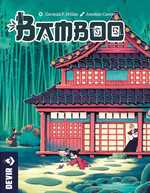
Bamboo Board Game
For generations, harvesting bamboo has brought prosperity to your home. Work, perseverance, balance and prayer have made a small town flourish that has grown at the expense of the cane fields. Today, various clans live in harmony with nature. In Bamboo, players take on the role of clans that grow bamboo and use the fruits of their labor to take care of their family and thus add happiness points. This is an action management and tile optimization game that is both accessible and deep.
With a very careful setting, Bamboo is part of the Kemushi saga, to which Bitoku and Silk also belong. Bamboo games are made up of 4 years or rounds, which in turn are divided into 4 phases or seasons. On their turns, players will burn incense in temples to seek favor from the spirits, and use bamboo shoots to perform actions such as seeking balance, cooking, home improvement, or managing finances. Following the doctrines of the home balance discipline allows for better optimization of home tiles, making it a fundamental pillar for progressing through the game. To score balance tiles you must use the balance action and follow the pattern indicated on the tile, which always has something to do with the type of home tiles you get during the game. There are four classes of home tiles: decoration, garden, faith, or useful. Depending on how they place them on their board, players will earn happiness points. In addition to managing the household, players will need to prepare for when tough times come. To get through the winter, it will be necessary to feed the family members with the tea, rice or ramen that has been prepared and stored in the previous season. And all this without forgetting to honor spirits and ancestors in the temples. The player who has made the largest offering of incense in each sacred space will receive the favor of one of the seven spirits of the forest, as a token of thanks. Spirit tiles, in addition to helping players throughout the game, offer bonus points in the final phase based on the number of different spirits in each player's play area. With accessible and easy-to-learn rules, Bamboo is a very versatile title that will fit into any shelves. However, behind its apparent simplicity lies great strategic depth, with plenty of options available to players. In addition, Bamboo has an advanced game mode on the back of the personal boards, which will give the games an extra level of demand. Harvest bamboo and find balance in your home to win the game. May the spirits be with you!
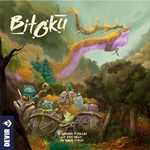
Bitoku Board Game
In this game, the players take on the roles of Bitoku spirits of the forest in their path towards transcendence, with the goal of elevating themselves and becoming the next great spirit of the forest. To do so, they will have the help of the yokai, the kodamas and the different pilgrims that accompany them on their path. This is a hand-management, engine-building game with multiple paths to victory.
Players will have yokai represented by the cards that make up their hand, which must be placed in the right places at the right times in order to obtain the maximum benefit from the abilities they offer. Furthermore, during the game players can earn more yokai cards for their deck, thereby increasing their playing options and achieving a higher score. Each player also has three yokai guardians (in the form of dice) that they can send to the large regions of the forest on the main board in order to obtain all kinds of new options that they can play during the game. These options can be structures they build in certain areas of the forest, soul crystals that generate resources when certain actions are carried out, and many others as well. The players also have the chance to help the mitamas, lost souls in search of redemption by using the chinkon fireflies.
There is truly a wide range of actions to carry out, and this is without taking into account the personal domain where the players can lay out another layer of additional strategy while managing the pilgrims. Pilgrims are followers of the player who embark upon journeys of contemplation and reflection who then share the experiences and learning they can along the spirit path with the Bitoku.
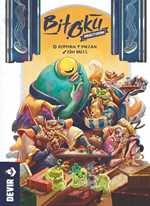
Bitoku Board Game: Resutoran Expansion
Enjoy a new taste of Bitoku with Bitoku: Resutoran, a three-module expansion that you can add to the base game as you prefer. Do you want the full menu? Add all of them! Do you want to try a bite? Add just one, and enjoy the banquet. Itadakimasu!
Modules include new Iwakura rocks, new Yokai cards, and three new types of Kodama Lake. Also, Resutoran includes a new deck of cards that will allow players to activate certain effects during the game, such as modifying dice results (whether their own and opponents') or gaining a lot of points.
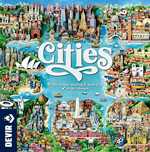
Cities Board Game
You've been tasked by the city council to put together a plan to transform a whole neighborhood in the city. You have the opportunity to build new housing, office buildings, parks, and leisure areas near the waterfront. It is in your hands to make the city a better place.
Cities is a city-building game in which you draft the best projects and arrange them in your own playing area. Designed by Steve Finn and Phil Walker Harding and illustrated by Jorge Tabanera, it allows games for groups of 2 to 4 players, ages 10 and up, lasting about 40 minutes. With action and resource draft mechanisms, it will give you the opportunity to visit the cities of Sydney, Venice, New York, Barcelona, Rio de Janeiro, Lisbon, Mexico City, and Buenos Aires. Can you design the most magnificent neighborhood?
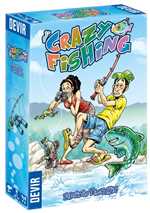
Crazy Fishing Card Game
You thought it would be a nice relaxed day on the water, waiting for the fish to bite and watching the clouds drift by? but now it's a frantic race to catch the biggest fish and prove once and for all who is the best fisherman!
Use the right bait with your best rod and reel to lure out the biggest fish you can catch! Make sure you have the gear you really need so you can beat the competition and get those fish faster!
In Crazy Fishing two to six players become fishers who compete to catch the biggest fish in the sea. You play over a number of rounds divided into three steps: The cast, where all players play simultaneously and choose and play one Rod'n'Reel card and one Bait card; The catch, where they catch fish based on the Speed of the Rod'n'Reel cards and Reel'em in! where you refill your hand. The winner is the player who has the highest scored obtained catching fishing and bonus cards.
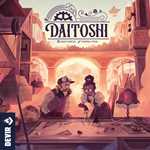
Daitoshi Board Game
We have finally perfected the power of steam, and we can now use it to our advantage! We live in an unprecedented era of progress, and new steam-powered inventions are developed faster than ever. Cities are growing, trade is flourishing, and we are developing our most ambitious machine ever: a giant contraption that will bring even more progress to the city. Yes, some trees are being cut down, and the river doesn't flow as plentifully as before, but there's still an abundance of trees and water, and we can use the extra space to expand our city - and it's not like the old creatures on those forests can do anything about it.
On your turn in Daitoshi, you either produce or move your magnate to a new district in which you will be able to send your workers to work, command the exploit of forest or river hexes to fuel your endless need for steam, and perform an action to expand and show your greatness to the city.
These actions not only help you in your search for acknowledgement, but help all the inhabitants of the big city. You will expand the city and electrify its districts, discover and develop new steam-powered inventions, and trade with faraway cities. You may even help the city build its gargantuan project: the mega-machine. Some forests might be cut down, and some rivers may be dried up, but in your generosity, you will help the displaced workers from those areas by giving them new jobs at your service.
Old legends suggest the forests and rivers are guarded by Yokai, but progress can't be stopped because of some old fairy tales. Just in case, though, it could be wise to participate on some reforestation projects and hide your participation in the abuse of the natural resources...

Espana 1936 Board Game
ESPAΞA 1936 is a game of historical simulation that recreates the facts occurred during the Spanish Civil War (1936-39).
It is played on a board depicting Spain and divided in connected zones, with counters at operational level. It has cards to develop the events of the war and to modify decisive battles. It does not have any CRT, and the combats are simple but real for the conflict. The turn and the combats are alternative, which creates a great interaction between the players. Thought for beginners and experts alike.
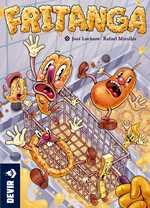
Fritanga Card Game
Set in the Blind Business universe, Fritanga is a card game for cooking lovers where the playing area is... a fryer!
Players take control of various foods and try to survive at all costs, jumping from one side of the fryer basket to the other. When a player cannot move, they fall into the boiling oil, being fried, and (unfortunately) eliminated from the game. You must use all the cards you collect to survive and not become deliciously battered.
Fritanga has three game modes: free-for-all, suitable for 2 to 6 players; the mode against the chef, a semi-co-operative version for groups of 3 to 7 players, in which one will be the chef and will try to fry the rest of the players; and team mode, in which two equal groups compete to win. Each game mode has a few different cards to tailor the experience.
After assembling the central board with nine cards, which represent spaces on the fryer grid, players begin their turns, which are divided into two phases: playing cards and moving. The first phase allows you to play as many cards as you want, with the aim of improving the position in the fryer or annoying and attacking your rivals. The second phase allows you to move 1-2 cards away. At that moment, the card you reached is revealed, then either an effect is triggered or you can claim that card to use it later.
So get ready, set, fry!

Go Cuckoo Game
Help Kiki the cuckoo build her nest! In this fun dexterity game, you must place sticks into the nest so that they support the eggs. But do it carefully, because with one false move and the whole structure could come crashing down.
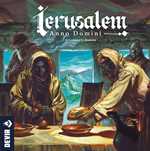
Ierusalem Anno Domini Board Game
Jerusalem, spring 33 AD. A crowd gathers at the city gates to welcome Jesus of Nazareth as he prepares to celebrate Easter with his apostles and followers. With a revolutionary message, he has garnered supporters everywhere but also looks of suspicion among religious authorities. The Last Supper will soon be celebrated and the fate of one of the most influential characters in human history will be sealed.
In Ierusalem Anno Domini, each player represents one of the communities of followers of Jesus of Nazareth who, coming to Jerusalem from nearby towns and villages, want to approach the place of the Last Supper and position themselves as close as possible to the seats of Jesus and his apostles. Ierusalem Anno Domini can be played alone or with up to 4 participants. The goal of the game is to gain points sitting your followers at the table of the Last Supper. The closer they are to the apostles and to Jesus himself, the more victory points they will provide at the end of the game. The parabola tiles that we have accumulated, or the offering tokens will also give us points. Different locations are shown on the board: the market, the desert, the mountain, the lake and the temple. After sending our followers to one of these locations, we will obtain stones, bread and fish, as well as denarii or cards that will allow us to do more than one action. Among these actions, players will be able to choose between listening to a parable, going to the table, changing seats or doing a favor, among others. All this will happen while the patience of the Sanhedrin runs out. When this happens, symbolized by a tile moving in a marker, the endgame is triggered. However, the main element of the game is the cards. Each card has a symbol corresponding to one of five key locations in the game. As you play them, combinations will be formed that will allow us to bring the apostles to the table of the Last Supper. The optimal placement of our followers around Jesus and the apostles will also be done through the management of letters, as well as various resources at our disposal. Behind a very immersive theme, Ierusalem Anno Domini will not disappoint lovers of good challenges. Players will have a wide range of possibilities at their fingertips and multiple ways to earn victory points. Preparing the best strategies to get the most out of your followers will be one of the keys to victory. Devout gamers don't need to look further: Here is your game!
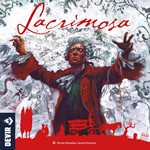
Lacrimosa Board Game
Wolfgang Amadeus Mozart is dead. His last conscious action on his deathbed was composing the Lacrimosa movement of his Opus Requiem. You, as one of his sponsors, will meet with the widow in order to participate one last time in the funding of the works of the Austrian genius. Also, you will reminisce and retell all your memories alongside Mozart in order to make sure that she portrays you under the best light when writing her memoirs in order to enter history as Mozart's most important patron.
In Lacrimosa, players take the roles of patrons of the late musician, contributing with their fundings to the composer's works one last time. During the game, you play in two different timelines: the present and the past. In the present, you commission the missing parts of the Requiem from other composers in order to complete it. When developing past events, the game takes place in five epochs in which you contribute by buying new compositions from the composer to sell or exhibit, accompany him on the different journeys through the main courts and theaters in Europe, and gather the resources you need in order to support the musician during his career.
During the game, you play cards from a limited hand that you will improve as the game progresses. These cards can be played either as actions or as resource generators, and players need to optimize their resources and finances in order to support their best version of the story and their relationship with Mozart.

Luna Capital Board Game
The dream of maintaining human life on the surface of the moon has now come true. The project to build cities on Earth's beloved satellite is under way. Things are moving full speed ahead too, the possibilities are enormous because this is 1977, the year when lunar living becomes reality. The most enterprising companies have decided to sponsor teams of scientists, builders, publicists and freelance nightlife entertainers to set out to construct the best client base in the galaxy. On top of this out of the world chance, the Lunar Colonization Authority shall assign the capital of the Moon to the best of the projects that are presented, making the chance for an even juicier reward!
In LUNA Capital, the players must optimally manage the elements of the game to build the best possible lunar settlement, and to make it worthy of becoming the capital of the entire off-planet colony. They will have a series of construction cards in a common 'market', and each of the players shall be tied to a number of project tiles. The players take turns drawing cards and the tiles that accompany them, and then place them in their personal playing area. The cards must be laid out in a maximum of three lines and must be placed so that they are always in ascending numerical value. Once the card has been placed, the tiles are then put on the spaces for them on the cards, in an attempt to group together the various projects in the most efficient way possible.
The tiles show what projects are available, all of which are essential for the construction of the city worthy of the term. They include oxygen collectors, greenhouses, residential complexes and (of extreme importance) sales offices to sell apartments with the best views in the galaxy. Each of these categories scores according to how they are arranged within the personal area of each player. Whoever is able to best take advantage of their arrangement and placement shall become the mayor of LUNA Capital.
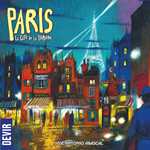
Paris Board Game: City Of Lights
Paris: La Cite de la Lumiäre is a two-player board game, designed by Jose Antonio Abascal, infused with Parisian aesthetics by the artist, Oriol Hern†ndez. The game is set in late 19th century Paris during the 1889 'Exposition Universelle', when public electricity was a hot topic. Electricity spread throughout the city, creating today's beautiful nocturnal Parisian streets and coining Paris's nickname 'La Cite de la Lumiere', the City of Lights. The most well-lit buildings are admired highly by passers-by.
In the first phase, players can either place tiles or grow their reserve of buildings. The cobblestone tiles are divided into 4 random spaces (their colour, their opponents' colour, a streetlight or a mixed-colour space where either player can build). Then, in the second phase, players build on top of their colour or the mixed spaces, in effort to position their buildings as close to as many streetlights as possible. More streetlights solicit more adoration and points. The player with the best lit buildings steals the hearts of Parisian pedestrians and wins the game!
An easy-to-learn tile-laying game for two players with a short play time but plenty of forward-planning required.

Paris Board Game: City Of Lights Eiffel Expansion
If you liked the original, Paris: Eiffel is a must-have addition that brings many more hours of fun to your Parisian nights. In this expansion we visit Parisian marvels such as the Arc of Triumph, the Luxor obelisk, the Louvre Museum, and obviously the Eiffel Tower.
8 new postcards that upgrade the replayability of Paris: La Cite de la Lumiäre, with new art by Oriol Hernandez.
New monuments that add a 3D level to your game experience.
Complete your experience with this must-have expansion to the two-player game that everyone is talking about. Requires original Paris: La Cite de la Lumiäre game.

Phoenix New Horizon Board Game
In the year 2021, after years of seclusion underground, humanity emerges onto the surface, propelled by the development of groundbreaking new technology.
Decades of catastrophic fallout from a nuclear disaster during the Cold War have laid waste to the known world, compelling civilization to seek shelter beneath the earth.
The pressing task now is the construction of regenerators, which will generate new habitats to facilitate the resurgence of life and the reclamation of the Earth.
A world brimming with hope awaits aboveground.
Phoenix New Horizon Board Game is a Euro-style board game in which players assume control of a team of commandos tasked with the mission of recolonizing Earth.
Throughout the game's four rounds, players accumulate victory points by constructing regenerators and buildings, bolstering the planet's population, and achieving diverse objectives that vary between playthroughs.
Players must adeptly allocate their commandos to various actions throughout the game while also specializing them to enable more potent abilities at the expenses of versatility.
Fulfilling missions assigned by the governing authorities yields additional actions on a player's turn.

Planta Nubo Board Game
"It was our darkest hour. The warnings, the desperate cries ? Nobody wanted to hear them. Until it was almost too late. When almost only burned soil was left. We were not saved by ourselves. It was the trees. As if they knew what the hour has struck. They showed us what mattered. But we understood and embraced them. Now we know what to do and help. As good as we can. With those few technologies that we have left. With new natural technologies that we gained from the Arbors. Green energy and oxygen are needed to overgrow burned soil with live-giving greenery. To find hope in our new world of Overgrown ?" (Dr. Ayleen Espero, specialist on oxygen)
In Planta Nubo players grow energy-rich flowers and plants in cloudy gardens ? the treetops of the Arbors. Deliver them to bee-like airships which transport them to the biomass converters to be transformed into green energy. Sow woods on the freshly harvested soil. Energize helpful modules while your woods, your bots and the Arbor produce desperately needed oxygen. Make good use of your tools to perform actions and use your garden bot to help you grow flowers. Supply your platform bot with energy to use modules and operate Oxyfarms. Turn your Arbor into the best oxygen production facility! If you produce the most oxygen by the end of the game you win!
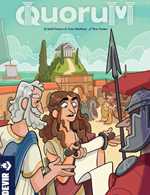
Quorum Card Game
The Roman Empire has spread over all the known world. Its civilization has expanded and is influential in all aspects of life, from trade and architecture to the power of its army and its political intrigues. The presence of the gods is made clear in the events of human lives.
In Quorum, the players take on the role of Roman senators who share the power of Rome and its provinces with the aim of acquiring the greatest amount of influence possible. The goal is to be the most powerful and influential senator by gaining victory points, which are awarded in various areas of influence over the twelve rounds of the game.
On their turn, players take and play a card in front of them to affect one of the provinces. The turns continue in this way until all the players have twelve cards in front of them. At the end of the game, the combination of cards played and the influence accumulated in each of the provinces will award players victory points, which will then decide who wins. Ready to dominate the Empire?

Rock Hard 1977 Board Game
It's 1977. You're an up-and-coming musician, dreaming of making it big with your band. Over the next few months you'll rehearse, play gigs, write songs, and promote your band. With careful planning and a little luck, you'll earn the most fame and become the best new artist of the year.
Designed by Jackie Fox (member of the 1970s rock band "The Runaways", four-time Jeopardy! champion, and designer of the narrative adventure trilogy The Adventures of the Chubby Slugz) and illustrated by Jennifer Giner, Rock Hard: 1977 allows games for groups of between 2 and 5 players, from 14 years old, in games lasting about 45-90 minutes.
Rock Hard: 1977 is played over a maximum of nine rounds, each representing a typical day of one month in 1977, from April to December. You win the game by accruing the most fame. How? Increasing reputation, chops and songs; achieving production, performance, and publicity bonuses; getting record deals and earning royalties; playing concerts; and hanging out at the hottest after-hours spot. Ready to live like a rock star?

Salton Sea Board Game
Salton Sea is a unique place located in California, very close to the border with Mexico. The characteristics of this salty lake make it a unique location to generate geothermal energy, which takes advantage of the heat from the planet. In this area of intense geothermal activity, you will drill the ground and extract brine which, once processed, allows us to obtain the valuable lithium and sell it as part of a modern industry, far from fossil fuels, that will allow you to lead the energy transition towards a completely renewable future.
Designed by David Bernal and illustrated by Amelia Sales, Salton Sea can be enjoyed alone or in groups of up to four players in sessions lasting about 120 minutes. During the game, players must manage their geothermal lithium extraction companies to obtain the greatest number of points. The extraction of this material and its subsequent processing will be the driving force of your companies.
On your turn, place one of your four engineers on one of the available spaces to take an action. There are three different groups of actions: industrial actions (which allow you to obtain an exploration license, drill, extract, process or repair machinery), commercial actions (sell, acquire contract and execute contract), and management actions (research, buy shares, develop the business project or finance itself). It is up to you to manage the engineers at each point of the game to get the most out of your company.
However, there is no single path to success. The game will reward you for exhausted land, executed contracts, short-term objectives, company development, or research advances. Will you master the power of the Salton Sea to create the most efficient geothermal company?
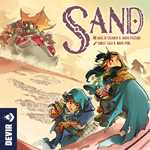
Sand Board Game
Travelers cross the desert that stretches from the slopes of the Akaishi Mountains to the cliffs of Seaclaw. Half-ruined ancient cities are home to the last human communities struggling to survive by foraging for what little green remains standing. These desert travelers transport goods on the backs of their caterpillars. Although their only goal is to make as much money as they can, at the same time and in a more or less deliberate way, they are helping to bring life back to the desert by carrying small plants from the artificial greenhouses of the cities to the most remote corners of this ocean of sand.
Designed by Ariel Di Costanzo and Javier Pelizzari and illustrated by Ernest Sala, Sand is a game with a main mechanism of pick-up-and-deliver that can be enjoyed alone or in groups of up to four players in games of about 120 minutes long. Players have to earn as much gold as possible after six rounds (five in a four-player game) to win.
In Sand, players put themselves in the shoes of these intrepid desert travelers who travel the paths of the board and visit the different towns. They collect goods to take them to other places and thus earn gold for the transport service. They cross the dunes on the backs of their faithful caterpillars, which, cared for, will grow and help players complete their tasks more effectively. Along the way they will be joined by helpful companions and be entrusted with missions that, if completed, will bring good benefits at the end of the journey. Help the plants take root again, and perhaps there is still some hope for this desolate place...
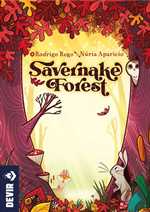
Savernake Forest Board Game
Autumn is coming to an end in the Savernake Forest... Help the animals gather and store food for the winter! Savernake forest is a game where 2-4 players build their own section of the forest with paths where animals and food will appear. To get the highest score, players must ensure that on each path the animals can collect their favorite food. Foxes, hedgehogs, beavers, owls, rabbits, woodpeckers, wild cats... Up to 23 different types of animals live together in the Savernake Forest. At the end of autumn, they all prepare to spend the cold winter with enough provisions and here you are to give them a hand... Or a paw!
To play Savernake Forest you have two decks of square cards, one showing the animals and the other with forest paths full of succulent food. Each player is randomly given an animal card, showing how many foods they can store and their preferences. For example, the fox loves eggs, but not berries or nuts. To get the best score, you must try to get each animal to collect its favorite foods. During setup, three road cards and one animal card are laid out for all players to see. Each player, on his turn, will choose one of them and add it to his forest, always respecting three rules: there can never be two animals on the same path; cards must be adjacent and no cards can be placed outside of a 4x4 grid. The game ends when all participants have completed their forest, with a total of 16 cards. Throughout the game, players will have the help of some animals, depending on the card they choose from the central market. The rooster will help you get up early, so you can be the first to choose a card in the next turn. The armadillo teaches you how to dig better shelters to store more food, so you can take a burrow token and add it to one of your animal cards to increase that animal's storage capacity by 1. The goat teaches you to hydrate yourself better, offering a water drop token that can be associated with a food and increase its value by 1. Finally, the rabbit helps you attract new animals to your forest. For players looking for more advanced challenges, the rulebook includes a two-player variant with some modifications that increase the difficulty. Quite a boost if you already master the basic rules! With a dreamy art, Savernake Forest offers a perfect balance between fun and strategy that makes it perfect for any type of playgroup. Family and friends will have a great time helping the animals of the forest, while trying to make the most of their paths to reach the highest score. Stroll through Savernake in the fall and be swept away by the enchantment of its wildlife!
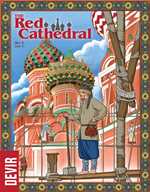
The Red Cathedral Dice Game
Autumn is not the best time to climb up on a scaffold in Moscow, but it is still far better than doing so in the winter. Tsar Ivan wants to see results and our team will prove to him that we are the best builders in the city. We are sure to finish off those decorative arches with the brightest shining stones and ensure our place on the list of the government's trusted workers.
The Red Cathedral is a strategic, É??EuroÉ?ù board game in which the players take the roles of construction teams. Their job is to work together to put up St. Basil's cathedral in Moscow, as ordered by Ivan the Terrible. However, only one of them will be able to gain the favour of the Tsar. During the game, the players can carry out one of these three actions: assign a section of the cathedral, send resources to that section to build it, or go to the game board to achieve more resources. Each of these actions has its own mechanism and requires that the players pay close attention to what the other players are doing. When the sections of the cathedral are assigned the players take possession of the spaces in each of the columns that make up their section. The more sections built and the completion of each with its own tower, the more points the player will be given at the end of the game. The players can send resources to the cathedral sections that they have claimed. When they complete each of those sections they will obtain rewards in money and prestige points. They will also be able to install decorations on the completed sections to achieve even more recognition from the Tsar. This part of the game also works as a clock, since once any player completes the construction of their sixth section it brings about the end of the game. The game board shows us the iconic rondel of The Red Cathedral. It is where the players obtain all the resource types needed to complete their work on the cathedral, as well as to get favors from the guilds and professionals to make the most of their trip to the market. In the central rondel the players choose the die they wish to use and move forward as many spaces as is shown on the top side of said die, in order to obtain the resources indicated in the space destined by the die. The Red Cathedral is a very accessible game with regard to its rules because it is very easy to understand the various levels of the game, but it remains very interesting with regard to strategy. It is sure to please those who are more interested in the challenge offered by trying to strategically optimize their position in each game rather than the complexity of the rules.
Contains:
- 20 Lumber
- 20 Brick
- 20 Stone
- 15 Gold
- 10 Green
- 10 Purple Jewels
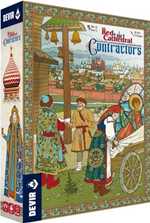
The Red Cathedral Dice Game: Contractors Expansion
Red Cathedral Contractors is another fabulous offering from Sheila Santos and Israel Cedrero, with stunning artwork again by Pedro Soto and Chema Roman.
Contractors increases the depth of the original Red Cathedral base game by opening up a map to the outskirts of Moscow, where we will have to send our contractors to recruit new professionals to help us in the construction of the Red Cathedral.
Contractors includes 10 new guilds that will add lots of variability to your games as well as stunning new decorations for your cathedrals.
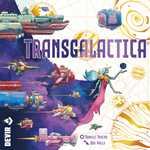
Transgalactica Board Game
Journey beyond known space and dominate the competition!
The Galactic Senate has launched the "Transgalactica Decree" in order to increase their knowledge and influence beyond the already well-known fringes of the galaxy. Fleets from every planet have been launched to the stars in search of adventure, riches, and (hopefully) an influential seat in the governing spheres that lie beyond the known space.
Transgalactica is a worker-placement and engine-building game with a high level of interaction between the players. In order to thrive in this game, you will travel the far reaches of the galaxy, improve your fleet's influence in all galactic matters, compete with other fleets for technological advancements, build a commercial network, and possibly even send representatives to the Galactic Senate to claim political advantages.
The game is divided into five rounds. In each round, players use their Captains to perform powerful actions in their own operations panel. Then, the other players may follow taking the same action using their crew, but without gaining a bonus. Little by little, players will increase their military power, political influence, or technology level, and earn victory points by exploring, trading, mining or completing missions. May the best spacefarer win!
May the best governor win!

White Castle Board Game
The heron flies over the Himeji sky while the Daimio, from the top of the castle, watches his servants move. Gardeners tend the pond, where the koi carp live, warriors stand guard on the walls, and courtiers crowd the gates, pining for an audience that brings them closer to the innermost circles of the court. When night falls, the lanterns are lit and the workers return to their clan.
In The White Castle, players will control one of these clans in order to score more victory points than the rest. To do so, they must amass influence in the court, manage resources boldly, and place their workers in the right place at the right time. The authors are Sheila Santos and Israel Cendrero, the duo known as Llama Dice who also designed the successful The Red Cathedral with Devir. In this case, we leave the Moscow of Ivan the Terrible behind to explore the most imposing fortress in modern Japan, Himeji Castle, where the banner of the Sakai clan flies under the orders of Daimio Sakai Tadakiyo.
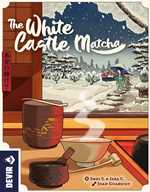
White Castle Board Game: Matcha Expansion
The tea ceremony lies at the heart of Japanese culture, giving life the most essential and elemental concepts of hospitality, respect, and Zen philosophy. There, they believe that tea, which came from China in the 13th century, resolved the health problems of the Buddhist monks who drank it. Over the years, the tea ceremony evolved to offer the samurai a place of calm, far from the chaos of the battlefield.
In The White Castle: Matcha, you will have to deal with a new place in which to influence the court using new members of your clan. Having members of your clan in good seats within the Chashitsu (tea room) will help you achieve a greater level of influence within the court of Himeji. Also, you will have one additional action each round. Will that be enough?
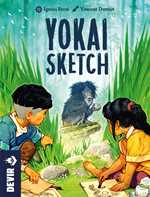
Yokai Sketch Card Game
Children who go into the forest may come across some yokai, that is, supernatural creatures and phenomena. Moved by boundless curiosity, the little ones draw these spirits in their notebooks to understand their nature and learn from them.
With a set-collection core mechanism, the goal of Yokai Sketch is to score more yokai points than the other player by completing sketches of the elusive forest spirits. The game consists of two decks of cards: in one are four types of yokai, each associated with an element (water, fire, earth, and wind) and a numerical value that corresponds to victory points, and in the other, sketches made by humans, two of the four elements, and possibly a special ability.
At the start of the game, the yokai cards are stacked in four decks (one for each element) and three sketch cards are dealt face down to players. On their turn, players draw a new sketch card and slide one of their four cards under one of the four decks in the center of the table so that it reveals the element associated with that yokai. If by doing this the yokai reaches or exceeds the number of sketches needed to draw it (adding the sketches on both sides of the card), the player who has accumulated the most sketches on their side of the table takes it.
The winner's sketch cards will be placed in the discard pile, and the other player's will stay where they are as they will be used for the next yokai card of that type. If there is a tie in the number of sketches on both sides of the card, the yokai is frightened and lost. In this case, neither player manages to finish the drawing and all the sketch cards on both sides of that yokai pile are discarded. Sketch cards can also include powers: calling the yokai or distracting it to move cards. The game ends when one or more yokai decks are empty.






